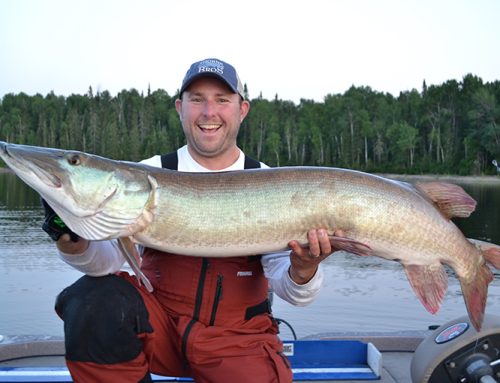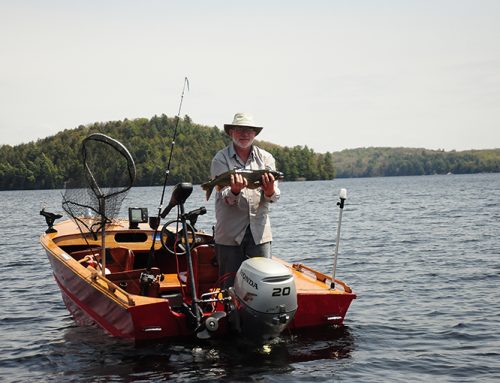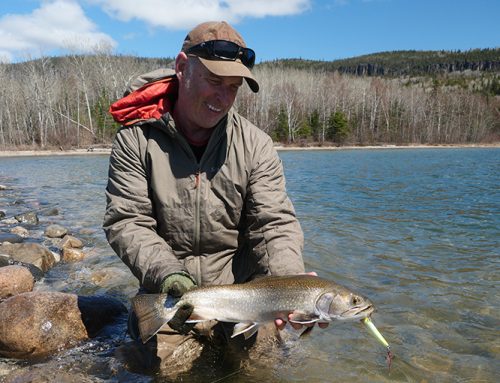
Many anglers are passionate about smashing giant largemouth in heavy cover. The feeling of fishing shallow, matted grass with a big rod and a short line is addictive.
Largemouth spend their lives below this canopy. Reaching them, though, has never been easy and landing them can be even more challenging. If you have the appropriate mindset and gear, however, you can master this exciting tactic.
“Punching is such a blue-collar way to fish,” said Mike Miller, host of the Ontario Federation of Anglers and Hunters’ Angler and Hunter Television. “You don’t need expensive electronics. You just fish. It’s so rewarding.”
Weather watcher
Go punching when conditions are changing. Adverse weather prompts bass to seek dense cover. Gusts collect debris and chopped-up weeds and heap them along shorelines. Floating grass makes docks, trees, pads, and weedbeds even better.
Some of the best places include reed, cane, and undercut banks. Nicknamed “slop,” entangled floating weeds create the perfect cover for schools of largemouth. My favourite tactic is to focus on smaller, isolated mats, which are proven monster bass hangouts.
Finding the best sections of a mat takes time and experience. To make the most of your time, focus on irregularities, mixed grasses, and shoreline composition. The shore will often reveal what’s below the water and under the grass. Never ignore changes in topography.
Hammer time
Punching has the well-deserved reputation of putting monsters in the boat. Reels spooled with the heaviest of braid and paired with an extra heavy eight-foot rod are ideal. Punching for beasts all day, however, will exhaust your arm. I recall a multi-day tournament where we punched from launch to weigh-in. The following week, I saw stars if my elbow moved the wrong way. Scaling down to a shorter, lighter rod makes punching easier on your body but still allows you to drop the hammer. Search for a rod with a parabolic bend, which offers power without straining knots or hooks.
Don Sangster, adventurer and OOD contributor, has always loved mat fishing. Over the years, he’s scaled back his equipment. Now, his go-to set-up is a 7′, 2″ medium-heavy rod with braided line and a locked drag on the reel. “This rod action handles a 3⁄4-ounce weight well. If I move to larger weights, I go to a 7′, 6″ meat stick,” he said. Most of Miller’s many tournament wins were made possible by boating a kicker bucketmouth in shallow water. The ultra-stiff fishing rods he once loved don’t cut it anymore. He now favours 13 Fishing Omen Black rods 7′, 4″ to 7′, 6″ in length with a more moderate action. He’s even scaled down and routinely fishes 40-pound braid instead of 65.
Trolling motors off
Stop the trolling motor. The shallower you are, the more critical stealth becomes.
“Since anglers have powerful, weedless trolling motors like my Minn Kota, they tend to rip right through grass,” Miller said. “They spook so many bass doing that.”
Buck conventional wisdom and fish with the wind at your back if possible. As the boat drifts, lock it in place with your shallow water anchors. Stop at key areas, including edges, holes, thicker clumps, and where different vegetation merges.
The basic rig
TUNGSTEN WEIGHT: Tungsten has revolutionized punching. These dense, compact baits have the heft needed to plunge through. Switching to tungsten allows a 3⁄4-ounce weight to do the work of a much larger lead weight.
“The shape of the weight is something most overlook,” Sangster said. “Worm weights tend to be more torpedo shaped, whereas flipping weights are blunt and stubby. I find sleek worm weights drive through the cover better.”
HEAVY LINE: Low-carrier braid offers greater abrasion resistance than high-carrier lines. Its rougher, less round profile slices grass well.
Miller adds a 20-pound Sufix fluorocarbon leader in ultra-clear wate. He finds it makes all the difference.
THE HOOK: #2/0 or #3/0 straight-shanked, off-set, or wide-gapped hooks with a welded eye, bait keeper, and strong construction.
THE BAIT: Bait selection is not the star here. Stick to durable, streamlined plastics as they withstand the trauma of punching. Beaver-style baits are made for this, as are craws, tubes, and creature baits. If you don’t get a bite when the bait initially plunges through, jiggle it so bass can find it.
Punching with skirted jigs
Many bass jigs on the market are too bulky for punching. Building your own punching jig is simple. Thread on a neoprene bobber stop and a magnum bullet weight. Before you add the hook, however, add a punch skirt. If you don’t feel like making one, you can buy Ultra Tungsten’s Ultra Punch. The lush skirt flares like a jig without the bulk.
Punching isn’t easy, but the rewards are worth the effort. So, pick up a big rod and hammer out some big ones this summer.
Originally published in Ontario OUT of DOORS’ 2023 Fishing Annual






Leave A Comment